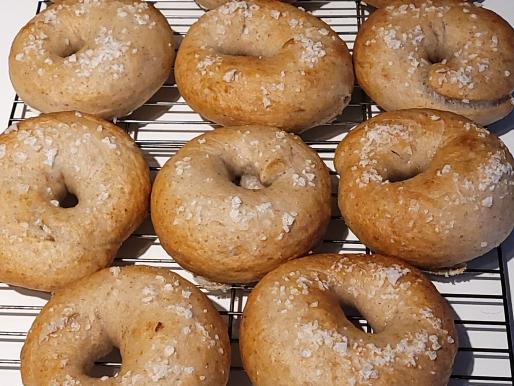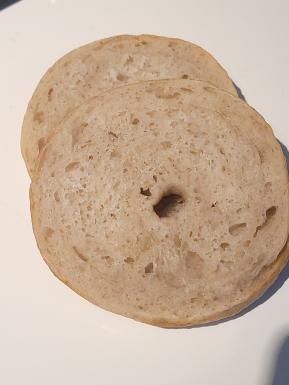Been a while since I had some bagels and have been craving them, so it was clearly time to revisit this wonderful recipe from Peter Reinhart in the Bread Baker's Apprentice. I've done this at least 2 or 3 times in the past always going with the poolish and commercial yeast version. I figured it was time to try the full sourdough version.
RECIPE AND CALCULATIONS HERE
One of the first things I noticed was how much starter/levain I needed. 992 grams! Wait...really....yes really!

The amount of starter here is no joke...but it also includes all of the water in the recipe and ends up being about 50% of the total dough weight. Next we had to deal with flavor. Bagels flavors can vary far and wide. Sweet, sure! Savory, of course! For me though, I have always loved an onion bagel. To that end I decided to re-hydrate 55 grams of dried onion flakes overnight and then drain off the liquid. This was then added directly to the dough to be incorporated throughout. This worked wonderfully and the bagels do indeed have a nice flavor of sweet onion in every bite.

In the photo it almost looks like candied ginger, but is in fact onion. After mixing the dough (I needed to add more flour at mixing for adjustments it was time to scale, pre-shape into small rolls, and then final shape into bagels. Each one was approximately 130g. I also made 2 as full dinner rolls (no holes but still boiled and baked) to be used as hamburger buns later in the week!


Some of the spots of color you are seeing in the dough is rye. My starter was 10% rye in this case. There are a few ways you can actually shape the bagels and have been successful with both. The first is to pick up the round....pinch the middle between your thumb and another finger until you can poke a hole...then gently stretch this out into a ring. The second is to roll the round out into a rope about 20cm long....then wrap it over and around the back of your knuckles...overlap the ends and roll that part together to seal the ends into a round shape. That is what I did this time and found it to be quite a fun and satisfying experience. At this point the bagels were placed on a pan, covered, and sent to the refrigerator for about 24 hours to do their final prove.
The next morning a quick float test confirmed that the bagels were ready for the bake. (Simply gently place a bagel in a bowl of cold or room temp water. If it floats within 10 seconds you are ready to boil and bake).
After bringing a pot of water with a tablespoon of baking soda to a boil each bagel got a bath. While this can be as little as 30 seconds per side I go a full minute per side and end up with a very chewy and firm bagel.

Once removed to a baking tray it is time to decide on toppings. Here the world is your oyster and you can go with literally anything. I always have home made EVERYTHING BAGEL SEASONING in the house as it's great on avocado or fresh tomatoes. Of course it's good on bagels too, but this time I opted just for some flaky sea salt.
I extended the bake a little bit to get some extra color on the bagels but the result was better than I had hoped for.



Sensei's Report Card
Tasting Notes: A nice thick and chewy crust with a soft and chewy crumb. Exactly how I like a good bagel. The onion flavor is pronounced and delicious. Excellent toasted, or as is with some cream cheese or other toppings of your choice. I'm not sure if I can taste the sourdough vs a preferment and commercial yeast addition because of the onion, but I would continue to do this with sourdough in the future.
Time/Effort: Three day process starting with a levain build on the morning and evening of day one, mixing and shaping on day 2, and finally boiling and baking on day 3. This is my normal sourdough schedule so It's not out of the ordinary for me. HOWEVER! And this is a big however for me and potentially for you. You MUST have room in your refrigerator for these to have time to do a slow long rise. For me this meant I needed to take 2 of the 3 shelves in my refrigerator. Thankfully I planned to do this and was able to move some other things around, but if your fridge is full, you might want to skip this one until it is a bit more roomy!
Would I make it again: Absolutely! I love a good bagel and have always been impressed with the quality of bagels I can produce myself. Not sure what the next flavor will be, but these will happen again...and again....and again.